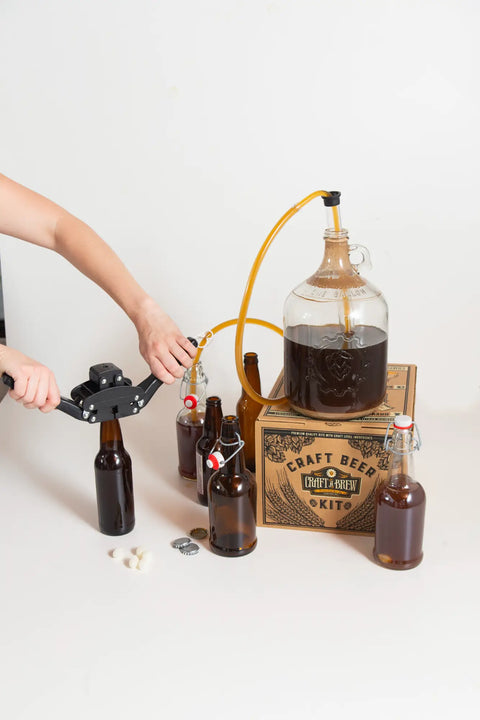TL;DR: Homebrewing Mistakes to Watch Out For
If it’s your first time brewing beer, don’t worry—every homebrewer makes mistakes. The good news? Most are easy to prevent. From sanitization slip-ups to fermentation issues, this guide covers the most common brewing errors and offers straightforward homebrewing troubleshooting advice. You’ll also find craft beer brewing tips and practical strategies for how to avoid brewing mistakes, so you can spend more time enjoying great beer and less time stressing about your setup.
-
Poor Sanitation – Always sanitize everything that touches your beer.
-
Not Controlling Temperature – Fermentation temps affect flavor and success.
-
Skipping the Instructions – Follow your kit’s recipe and timings carefully.
-
Using Old Ingredients – Freshness matters, especially with hops and yeast.
-
Bottling Too Soon – Let fermentation finish or risk exploding bottles.
Avoid these, and your first brew will be one to be proud of!
Introduction: Brewing Is Easy—But Not Mistake-Proof
Brewing beer at home is one of the most satisfying hobbies out there. Few things compare to cracking open a bottle of craft beer you brewed yourself. But while the process is approachable, first time brewing beer can be intimidating — and mistakes are easy to make if you don’t know what to watch out for.
At Craft a Brew, we’ve helped thousands of beginners take the leap into brewing with our first timer friendly Beer Making Kits. This new homebrewer guide outlines the most common homebrewing mistakes and shows you exactly how to avoid brewing mistakes with simple, beginner-friendly steps. Whether you’re looking for craft beer brewing tips, homebrewing troubleshooting, or just reassurance that you’re on the right track, we’ve got you covered.
1. Not Sanitizing Properly
Why It’s a Problem:
Sanitation is the foundation of brewing beer at home. Cleaning equipment removes dirt, but sanitizing eliminates bacteria and wild yeast that compete with your brewer’s yeast. If contamination gets into your beer, you may notice sour, funky, or undrinkable off-flavors.
How to Avoid It:
Use a quality no-rinse sanitizer on every surface that touches your beer after the boil — fermenters, funnels, thermometers, spoons, tubing, bottles, and caps. The only organism that should ever touch your wort is the yeast you pitch.
Pro Tip:
Craft a Brew kits include oxygen-based no-rinse sanitizer — enough for both brew day and bottling day — so you don’t have to hunt down extra supplies. Many advanced brewers also use acid-based products like StarSan, but the principle is the same: sanitize everything, every time.
2. Letting Temperatures Get Out of Control
Why It’s a Problem:
Fermentation temperature is one of the most important factors in making beer taste more professional and less homemade. Yeast needs a stable environment to thrive. Too warm and you’ll stress the yeast, causing harsh and boozy flavors. Too cold and fermentation can stall, leaving you with a half-finished beer.
How to Avoid It:
Check the yeast packet or recipe for the recommended range (most ale yeasts perform best at 65–72°F). Keep your fermenter in a cool, dark spot where temps remain steady. Even minor fluctuations can cause unwanted flavors.
Pro Tip:
Our 1-gallon beer making kits include a lab thermometer to monitor temps while steeping grains and chilling the wort before adding yeast. To monitor temps during fermentation, a simple stick-on thermometer works wonders. Can’t keep things cool? Try storing your fermenter in a large hard cooler or soft cooler bag and add some ice packs. This creates a cool fermentation chamber even if you live in a warm environment.
3. Not Following the Recipe
Why It’s a Problem:
Just like baking, homebrewing is part art, part science. For new brewers, skipping instructions or “winging it” often leads to disappointment. Changing water volumes, boil times, or hop schedules may seem harmless but can throw off balance, body, or bitterness.
How to Avoid It:
Read through your instructions before you start. This way, you know when to expect key steps like dry hopping or bottling. Following the instructions ensures consistency, sets a foundation, and reduces the need for homebrewing troubleshooting later..
Pro Tip:
Craft a Brew beer kits include beginner-friendly instructions written specifically for first-time brewers. Once you’ve mastered a few batches, you’ll feel confident experimenting — but the best way to learn is by sticking to the script at first. Once you learn the basics, then you can begin to experiment or stray from the recipe as written.
4. Using Old or Stale Ingredients
Why It’s a Problem:
One of the easiest common brewing errors is using ingredients past their prime. Hops lose aroma and flavor quickly, yeast loses viability, and old extracts or grains can produce dull or even unpleasant results. Even if you follow every other step perfectly, stale ingredients will hold your beer back.
How to Avoid It:
Always buy ingredients from a trusted homebrewing supplier. Avoid kits that have been sitting on retail shelves for years, as freshness can’t be guaranteed. Generally, a kit purchased within the last 18-24 months will be suitable for use.
Pro Tip:
Craft a Brew kits are packaged to order and use nitrogen-flushed hops and grains to maximize freshness. Fresh ingredients mean your first beer will have the bright aroma and flavor you expect from craft beer.
5. Bottling Too Early
Why It’s a Problem:
Patience is crucial in beer brewing for beginners. If you bottle too soon, the yeast continues to ferment sugars inside the sealed bottles, leading to over-carbonation or dangerous bottle bombs. Cutting fermentation short — whether from impatience or scheduling conflicts — is a risky shortcut.
How to Avoid It:
Let your beer ferment for the full two weeks (or longer if fermentation temps were low). Look for signs that yeast is finished: no bubbling in the airlock, clearer beer, and a compact layer of sediment at the bottom.
Pro Tip:
If you want extra certainty, take two hydrometer readings 24 hours apart. If they’re the same, this confirms that fermentation is complete. Waiting a few extra days is never harmful — in fact, it often improves clarity and flavor. This is one of the most overlooked beginner homebrewing tips, but it can save your batch.
Final Thoughts: Learn From Mistakes — or Avoid Them Altogether
Every brewer makes mistakes, but you don’t have to learn them the hard way. By focusing on sanitation, temperature control, recipe accuracy, ingredient freshness, and proper fermentation, you’ll avoid the most common pitfalls.
First time brewing beer doesn’t have to mean first-time brewing mistakes. With the right approach and support, your first batch can turn out just as good as something you’d buy from a brewery.
That’s why thousands of new brewers choose Craft a Brew — we take the guesswork out of brewing beer for beginners with fresh ingredients, clear instructions, and proven results.
Ready to Brew Your First Batch?
Check out our Beer Making Kits and start brewing real craft beer at home today. For more guidance, explore our Homebrewing Blog for how to avoid brewing mistakes and more homebrewing troubleshooting tips.





